Silkies for showing and how to prepare for judging.

Showing Silkies and exhibiting chickens:
So, you've decided to exhibit your Silkies! Congratulations, you are about to embark on a new adventure, one that I hope you will find enjoyable and educational. You will see breeds of chickens you never knew existed and make new friends too.
The Silkie chicken is one of the most popular entries found at poultry shows and is well suited to showing being easy to handle and generally docile and calm.
What makes a show quality Silkie?
In any show quality animal, there is variety in appearance, and certain attributes appeal to different people. Show quality is highly subjective.
Below: A Silkie at a poultry show. This bird came first at a regional show.
Having a show quality Silkie is a whole package thing. You need a good looking, well cared for bird that is comfortable being on show and being handled.
Know the appearance that you like most, and find the breeder that breeds closest to what you like best. That will guarantee that, win or lose, you will be happy with the appearance of your Silkies and it will add much to your enjoyment!
Below: A poultry show in progress.
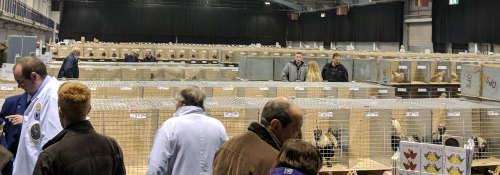
I'm assuming that you found a show you want to participate in, and have entered your birds. If not, check the Poultry Press, or the American Bantam Association or the American Poultry Association websites for upcoming shows.
You might want to bathe your Silkies about 3 to 5 days before the show.
At that time, also clip and reshape the nails, and trim and shape each bird's beak.
If your Silkies have large crests, hold each up at eye level and pluck any feathers that are obstructing the bird's vision. Just pinch the little feathers at the base and pull quickly. It's kind of like tweaking eyebrows, it hurts a little but they will see much better when you're finished!
Below: Here is a judge looking a chicken over at a show.
When you are finished, look at the Silkie's face at your eye level, and you should be able to see his/her eyes. Some judges will penalise a bird if they don't think it can see.
In one of my first shows, a judge did not place my best Silkie pullet any higher than 3rd because he said he didn't think she was able to see. Now I pluck enough so there is no question as to the bird's vision.
Top tip: Take a camera and take snaps of the other birds in your class! Take notes on where they came.
Never take a chicken or bird of any type to a show that has:
- Been ill.
- Has mites or lice.
- From a quarantine area.
- Has a disqualifying problem.
- Is not trained, happy relaxed and ready to be shown.
Below: Happy, well trained chickens make the best show chickens.
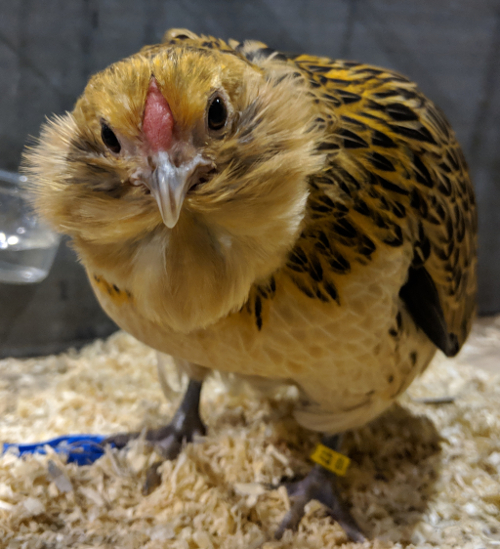
Sometimes it is best to not take a bird to a show. It is up to you to know whether there are any restrictions on you or your birds.
Whats in my showing supplies case?
Prepare your show supplies well in advance. I use a large tackle box but a plastic tool box works really well for this.
These are the items in my show box:
- Small container of shampoo.
- Clean toothbrush for dirty feet.
- Proper pet nail clippers and emery boards to trim, shape and smooth nails and beak.
- Paper towels and extra shavings.
- Comb and brush.
- VetRX.
- Scissors.
- Shout pump spray or small package of baby wipes.
- Oxine spray.
- Terramycin eye ointment.
I also take to poultry shows:
For the chickens:
- Water from home for my birds, I re-purpose gallon milk jugs.
- A large container of their regular feed mixture and treats.
- Small feed cups, however the shows usually provide a Dixie cup in each cage for feed.
- Pop bottle waterers.
And for me:
- Folding chair.
- Plastic zip ties.
- Cell phone and/or Camera.
- Business cards as people will ask you if you have Silkies to sell.
- Aspirin, Excedrin, Tylenol or your preferred headache remedy.
- Notepad and pen for the results, questions, tips and new ideas you'll want to write down.
- Gum or mints.
- Chap-stick.
- Magazines or reading material.
- Don't forget money.
Depending on how far the show is from home, you might opt to coop in the night before and stay in a hotel. If so, make your hotel/motel reservation in advance, and bring a change of clothes and whatever personal items you will need although you can borrow your Silkie blow dryer and shampoo if necessary.
Bathing Silkies:
I'd like to preface this section by stating that this is how I do things - it's not the only way, the absolutely correct way, or the way you should do it. It is the just the way we are most comfortable and the method we and our birds are happy with.
Below: A place on winners row takes preparation.
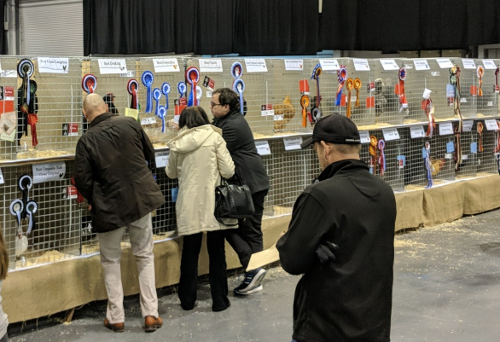
I only bathe my Silkies when absolutely necessary. Before a show, or if badly infested with external parasites, like mites or lice, is about the only time our Silkies get bathed.
When going to a show, it is usually recommended to bathe a Silkie about 3 days before the show. We bathe, clip nails and beaks if necessary, blow dry the bird and place the Silkie in a wire bottomed cage or in very deep shavings that are kept meticulously clean. There is nothing worse than spending hours bathing and drying a white Silkie, only to have it lay down in poop and undo all your efforts!
We bathe Silkies in the kitchen sink, although some day I hope to have a deep laundry sink with hot water installed in the Silkie building.
I arrange the shampoo, nail clippers, emery board, blood stop, towels, blow dryers, and comb before I ever get the bird.
Before the bath, I clip nails and shape the beak.
I fill the sink with warm water, and then add a squirt of no tears or pet shampoo / detergent to help cut through the natural oil on the bird's feathers and allow the water to get through to the Silkies skin.
I hold the bird in my left hand as I am right-handed with the bird's breastbone in the middle of my hand, and it's legs held tightly between my first and second finger and my third and fourth finger. Holding a Silkie this way gives you complete control and helps them to feel secure.
I lower the bird into the water and use my right hand to wet the Silkie all over. After the bird is completely wet, I apply the shampoo and lather the Silkie, paying particular attention to the feet, vent area, crest, and any other soiled areas.
I really like to use Adam's Flea and Tick Shampoo, as it will also eliminate any mites that are present.
Special shampoo for white dogs or horses helps to brighten white feathers, and I use it before shows, after the Adam's shampoo.
Once the Silkie has been completely lathered and I feel it is clean, I drain the water out of the sink, and turn the faucet on at a warm temperature. Still holding the bird, I rinse it under the warm running water, turning it to rinse each area, including the crest, which can be safely rinsed by tilting the bird's head back, and directing the water over the crest, being very careful not to allow the water to run forward into the bird's eyes or nose.
After rinsing, I roll the Silkie up in a large towel, making a sort of "Silkie burrito", and keep it wrapped in the towel for about 10-15 minutes, so as much excess water as possible is absorbed into the towel.
The chicken is unwrapped and the blow drying begins! I like to place the silkie on paper towels on top of the towel, because it usually will poop as soon as I unwrap it.
I use the blow dryer set on cool and high speed, and don't stop until the bird is completely dry.
If we are preparing for a show, and have a lot of birds to bathe, I set up some cages with heat lamps over them, blow dry each bird for 15 minutes or so, then put it under the heat lamp while I move on to the next bird, and go back to finish each bird after it has dried for awhile under the heat lamp.
When you wash them the oils are stripped from the feathers and need to be replenished to give them a nice shine. This is particularly important for black feathered chickens.
Feed has a lot to do with this, when they are laying the hens get nice red combs, too much sun washes colour out and not enough leaves combs pale. Corn, Milo, Marigold, dirt, soft food and medicines can effect birds feather colours. Some beyond repair.
We have both wire bottom and cage/pens with shavings. Personally I think the shavings pens with cement floor in our basement have better foot feathers. I have tried rubber mats on the dirt floors with shavings on top to no avail. Wire to me looks to shred the foot feathers to a degree.
Feeding show chickens:
Feed plays an important part of prepping the birds, ours are on a diet that includes plenty of flax seed for Omega 3 oils to keep the feathers shiny and in good condition.
Make sure your bird is healthy, not over/under weight, bathed, mite/lice free, banded, tested, and is used to a small cage. By this I mean is not going to walk the walls or fly to the ceiling and hurt itself.
It pays to have a cage where it is confined and has people walking by it during chores. Some people even train the birds to the stick the judges carry to teach it to set up, other birds pose naturally.
Feeding your chickens at the show:
Your chickens will need feed and water from when they first wake up in the morning on show day.
If you are only travelling a short way then this is just a normal morning but for longer journey plenty of organisation is required. You should plan feed stops as hungry birds can be bad tempered.
It is best to bring your own cage cups and water bottles. You know where they have been and that they are properly cleaned. Also the birds are used to them.
Poultry supply companies sell these but for Silkies you should make your own waterer that they can not dunk their crests into. We all know how our Silkies love to dunk their head in water right before the judge walks up, so I use the bottle waterers.
I use a Rubbermaid tubs for the feed. Don't forget the treats.
Take spare in case of delays or spillages.
Do birds get stolen at shows?
Do birds get stolen at shows, YES, occasionally and it is rare. Can you prevent it, to a degree yes. Be watchful of your stock.
Make sure to not accidentally take another exhibitors stock, It has happened and it was accidental, usually it is family members helping at coop out and things can move pretty fast/crazy.
Do not rush, triple check at coop out to make sure you have all your stock! Birds have been left behind at shows.
I also have zip ties and mini padlocks for cage doors.
Show training chickens made simple:
Show cage training birds is a simple process if started early and it is one they will have to get used to. A show chicken may be required to spend several hours at least In a cage and needs to be used to it.
Below: Judges will use a chicken stick and your birds should be used to it.
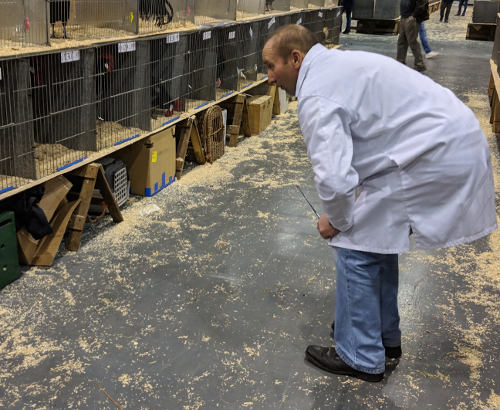
Your show chickens will also need to be used to people and being handled. There is likely to be hundreds if not thousands of people at a busy show and they may be judged several times.
It consists of placing each show bird in a cage similar to ones used by poultry shows about a month before the show. Start short, just 15 minutes at a time to begin with and move up to an hour after a week. Use feed and treats to smooth the process and make sure there is water on tap.
Handle each bird two or three times a day in a manner similar to that used in judging.
This is what the actual show cage or coop looks like. Most are on either a wire table, or on a table with tar paper and shavings. In the training process be sure to work with your fowl on wire as well as a flooring covered in shavings. Just in case.
Step 1 - Separate the birds into individual pens. Get them used to being in the shoe pens alone but next to other chickens.
Step 2 - Get them used to people coming up close to them and being handled and being treated for good behaviour.
Walk past the cage/coop two or three times an hour day. Get the bird used to seeing people. You don’t want the bird to cower in the corner of the coop or flap about and try to fly to the top of the coop when approached.
Pick them up correctly. Examine the head and wings, body and fluff. Check the vent area for parasites just as the judge would.
Reward them for good behaviour and offer them treats when you walk past the training coops or cages. Greens, scratch or Meal-worms, etc.
If you train your birds with a treat you will find the fowl has a better chance of getting the judges attention.
The bird will be expecting the judge to give it a treat when he/she is done looking at the bird.
To train using this procedure be sure to stop at the cage, pick up and examine the fowl, place it back in the coop, and give it a reward. This should be done two or three times an hour for two hours or so during the middle of the training period.
Once the routine is understood by the chickens extend the practice to the 5 hours of so the show will last in the final week.
The breed standards for the silkie chicken, and how to select Silkies for breeding.
At the show:
On the morning of the show, arrive at the venue early.
When you arrive at the show first find the check-in table and register.
Check your birds over, make sure each has clean feet and butt, spot wash if necessary.
Find where your birds will be caged and get each bird set up in the proper space, and equipped with water, feed, and extra shavings if needed.
I usually spray the show cages with Oxine spray, just to kill any bacteria that might possibly be there, and add extra shavings to each cage before I place my birds.
Scoop poop, and rub a little VetRx on each Silkie's comb and beak. Fluff feathers as necessary for the best presentation.
Check feed and water, then just walk around and look at all the other birds and meet other exhibitors.
The judges will be wearing long white coats, and will put a cord across the aisle when they begin judging. No traffic is allowed in the aisle while birds are being judged.
If you can handle the stress, watch the judge handle and evaluate your birds. The judge will remove each bird from the coop, and look it over thoroughly. Some judges will make little marks on the coop tag, especially if the class is a large one.
They will then mark their final decision for Best of Variety, Reserve Variety, Best of Breed and Reserve Breed.
Below: Judges have to be trained as well.
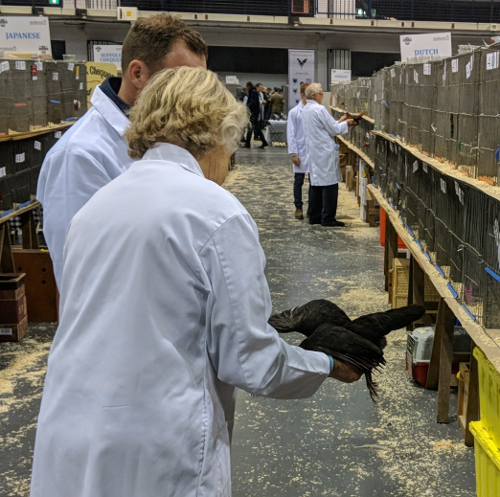
When all birds in a division (silkies are in the Feather-leg division) have been judged, the judge will then award the Champion Feather-leg and Reserve Champion Feather-leg. The division winner and reserve winner will then compete against all other division champs for the final awards on Champion Row.
When the show is over, I spray the inside of my carriers with Oxine spray (just to kill any bacteria that might have been present in the show hall) and spray each silkie under the wings with Adams spray (in case there were any mites or lice on any adjacent birds) before putting them in their carriers.
I always take my coop tags to record the show results in my own records. When we get home, the birds that have been shown are quarantined in a separate building for a week to 10 days, just to make sure they haven't picked up any chicken diseases. I also fog them with Oxine twice during that week.
Poultry shows are one of my favourite aspects of keeping chickens. I have met so many wonderful chicken people, learned so much from really knowledgeable folks, and generally I always have a great time, win or lose!
When you look over the flock look at the date of the show, figure out who in the flock will be in condition/old enough to show. Some people enter extras just in case, you can always leave the bird home if it is not ready.
Know the disqualifications for your breed/variety and make sure the bird you bring does not have one.
Filling in chicken show entry forms:
These are always a little different, try to get a copy of last years to practice on. most are available for download from the web in PDF format.
There will be something like :
B for Bantams,
L for Large Fowl,
W for Waterfowl, some want you to classify them by
FL which is Feather-leg.
Bearded or Non Bearded,
The colour - there are 7 standard colours in Silkies; black, white, buff, Gray, blue, partridge, splash.
Other colours are often classed as "Any Other or AO" and not in the book of Standards and these birds are not eligible for APA or ABA awards at the show but can be shown.
Than you have the sex/age of the bird:
C for Cockerel defined as 1 year and older,
H for Hen defined as 1 year and older,
P for Pullet female under 1 years old,
K for Cockerel male under 1 year old.
Some shows require a band on the birds and may want the number on the entry form. Poultry supply houses have different types of bands.
You will also need the bird banded when you have them tested for Pullorum-Typhoid.
My birds have permanent aluminium bands which are not easy for someone to get off the bird in a quick fashion.
Contact your State Board of Animal Health for a list of local testers! Cost for us is $.50 to a dollar per bird.
They prick the birds blood vessel in the wing area to do a quick test that only takes a few minutes to see if you have positive birds or not.
Very unlikely you will have any, but good to know if you did.
You need this form from your tester to show, each show/state has their own time line on how old the form can be to show your birds.
Pay attention to what your catalogue says or call that states board of animal health yourself.
Make sure you keep a copy or list of what you entered for a show handy when it comes time to wash and load the birds.
You should take high resolution images of your chickens with any identifying marks showing to make identification easy.
When you arrive go get an exhibitors list and find out your number, cage cards will not have your name, find the area for your variety and breed. Figure out your cages, set up your food/water, make sure to bring your own bag of shavings, many clubs work off of donations and have very lil in cages. Coop in birds, recheck all the birds for poop, egg eating yolk messes, and put in cage.
During the show make sure to NOT be in any aisle where a judge is working! WAIT to ask any questions until he is done judging! It is tacky and bad manners to do otherwise!
Showing, Judges, and Competition:
It is one persons opinion on that given day and at that moment, it may be different in another show although quality generally stands out.
Below: A judge in a poultry show.
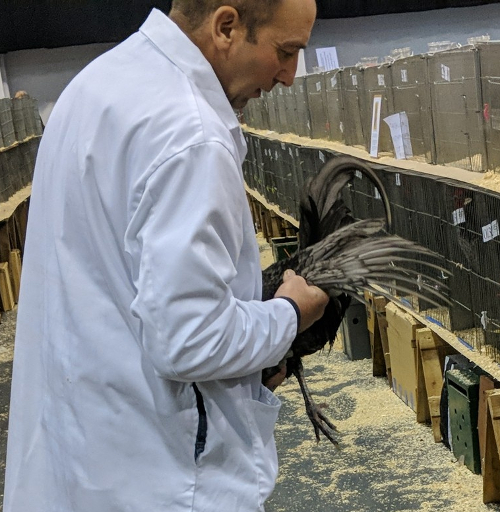
Travel out of your area to shows for a better idea on the quality of your birds.
Ask judges questions but only after the judging has finished.
Congratulate the winners, do not take things to personally and have a good time!
What awards can you win at poultry shows?
Ok someone reminded me to talk about placings. Please remember it varies the world over and from show to show.
Most shows place birds 1st thru 5th in each variety/sex.
For example - Bearded white Silkies:
You have 4 classes; based on sex and age. Cockerel, Hen, Pullet etc and each will have placings 1st thru 5th in each class.
Then you will have a (BV) Best of Variety sometimes called (BC) or best in class and then a reserve out of all 4 classes.
Silkie association gives points to members with a BV, RV, and the two bigger honours which is BB=Best of Breed and RB=Reserve of Breed.
The next level at the show for Silkies because they are in the Feather-leg class with a number of other bantams such as Cochins, Brahmas. It starts to get quite competitive at this level.
So you can get Champion Feather-leg or Reserve Champion Feather-leg.
The next level higher at the show is Champion Bantam or Reserve Champion Bantam at the show of all the Bantams in the show!
And than they have Champion And Reserve Champion of the show period.
All of these higher awards can get you points with the different associations if you are members of them. Some points are based on class size and number of exhibitors, and points can vary per show.
Don't forget to write it all down and take some notes and pictures.
Travelling to the show:
After spending months preparing the birds you think about how you are going to travel with them to the show. Are going to put them into that, chicken crate or wire cage, place them in the back of the truck and drive to the show?
Well think a minute about the feathers. Feathers the primary outer covering of the bird, and the condition of that feather will be responsible for as much as 25% of the points awarded.
If your prised birds are in a wire cage, in the back of the truck, van or car, the wind is going to rip right through the feathers while you are driving.
Feather-legged breeds both large and bantams walking on wire tear up the feet feathers. Even the clean legged can get their nails caught in the wire.
While travelling, the poultry will use their wings for balance, thus on wire they will tear up their wing feathers if you have a long drive.
So what can you do? Well there are many options for the exhibitor to use.
Personally I like the plastic pet carriers or solid wood boxes.
I Place a layer of shavings on the bottom, and transport the fowl that way. You can use wooden boxes specially made for the chickens. If you’ve been to the show’s you will know the ones I’m speaking of.
They come in two holes, four holes, even single, but they are custom made for your breed.
The good old cardboard box is always an option and is much better than that wire cage.
Regardless of your choice of carrier, do what you can to protect the feathers, wings, and feet of your bird during transport.
If you have no other option but that wire cage here is a few tips that might protect the feathers a little better during travel.
1. Put paper or carpet on the floor of the cage and up the sides about two inches.
2. Always use shavings on top of that. They collect the stool and keep the bird from slipping.
3. Duct tape on the wire (inside and out) on the wire where the tail and breast might hit will protect these pointed area’s should the bird hit the sides during the trip.
Good luck at the show. You spent a lot of time getting the birds ready for the show, don’t blow the best by getting there without thinking.
It’s the little things that make the difference between that first place and Champion.
General Scale of Points. Please bear in mind these are different to some degree depending on which country you are showing in.
All Crested or Bearded, or both; Crest, shape 8, colour 4; Beard, shape 3, colour 1.
In order to allow extra point value for these distinctive breed features, it is necessary to deduct proportionately from all sections in the Scale of Points, so the total allowed will not exceed 100 pts.
For example - To allow 12 points for crest (shape 8, colour 4) deduct (1) point each from shape of comb, wattles, ear lobes, back, tail, wings, breast, body and fluff (total 8) and (1) point each from colour of ear lobes, neck, and breast (total 4) making a grand total of 12.
Cage preparation:
Preparing the birds before they go in the cage is very important. They birds need to look their best for the judge.
Below: It is up to you to get your birds looking their best and it takes practice.
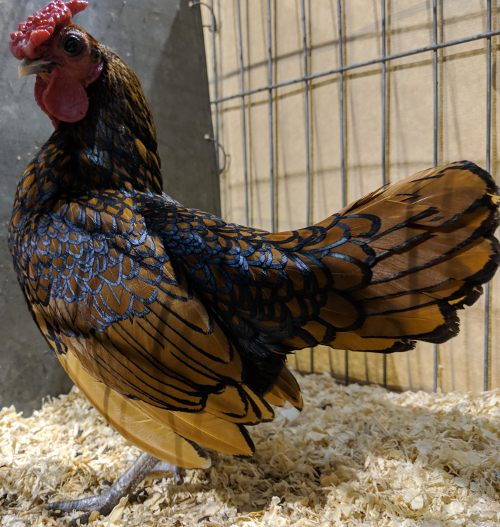
On light coloured birds use plain unscented baby powder on butt and foot feathers, it helps to keep poop from sticking to feathers!
Hand lotions, Blue Ribbon or horse face cream, work well on combs & wattles. A toothbrush or eye brow brush is handy for face and comb areas.
There are many finish sprays for smooth feathered birds, poultry supply companies carry them and look in the cow section of the farm supplies! I use a horse finish spray myself for the Cochins & Silkies.
Make sure to bring a chair to sit in at show, towel to lay on your lap, hand and face towels. And the tackle box with brushes, blow dryer, etc for final cleaning before judging.
Something we do not do is hold back food or water to keep the birds clean, it is more important to us that our birds stay healthy and happy so they are fed/watered well before, on the trip, and at the show.
Keep the cage clean at the show! Add lots of shavings to suck up the poop. Use a paper towel or rubber gloves and keep the cage clean!
Keeping your chickens happy at the show:
Make sure your birds have access to feed and water. Hungry or thirsty birds may stress out.
Treats are a good idea but only the odd one. As deep a layer of shavings as you can get away with with some scratch in to keep the chicken busy and scratching.
You will have to leave the area during the judging process.
The Truth About Show Quality:
Like the old saying about beauty, show quality is truly in the eye of the beholder.
Basically, any Silkie can be shown, but the big question is, can that Silkie compete, and have a chance to win?
If your bird is healthy, you have the correct paperwork, and you pay the entry fee, there isn't a show around that will turn down your right to show your bird, regardless of its quality.
So, show quality can be a real misnomer. If your bird can't really compete with the others in its breed or in its division, then it isn't a show quality bird.
A quick note about show quality hatching eggs:
Lately, I've seen ads online at places like ebay and etsy for "show quality Silkie eggs", as well as "show quality Silkie chicks".
I may not be popular for saying this, but eggs and chicks cannot be show quality.
Eggs from champion show birds can yield a champion, but can also yield mediocre Silkies. Silkie chicks can't be evaluated for show quality until they are at least 3-4 months old and I never assess mine until they are 5 or 6 months old. It is a little breed dependant.
If all champions created champion offspring, then Secretariat would not be a one-in-a-million horse, and champion show dogs would be a dime a dozen.
Olympic athletes would all have athletic, record-breaking children, and all movie stars' kids would be gorgeous. Genetics is a lot more complicated than that. It takes lots of work to create a champion and then even more work to pair that champion with another that will improve it even further.
Even when you have that "magic" breeding, all the offspring will not be champions.
So, what does that mean to you? If you want a "show quality" Silkie that can compete as well as be entered in a show - make sure that the breeder you purchase from actually shows his or her Silkies, or has competed enough in the past to have an understanding of what constitutes a competitive show quality bird.
If you are buying chicks or eggs, understand that although they may have show quality parents, that does not guarantee you show quality offspring.
Disqualifications from poultry shows:
Certain behaviours can get you excluded from shows and future events so be on best behaviour.
Conditions and faults can result in birds being disqualified and you should know what they are before entering the show. Read and understand the Standard of Perfection for your breed, and know what you like.
